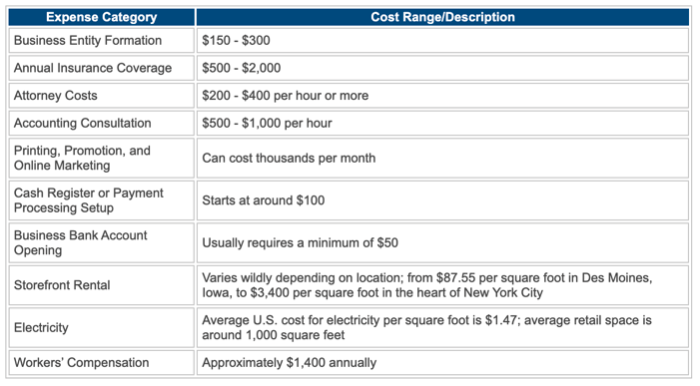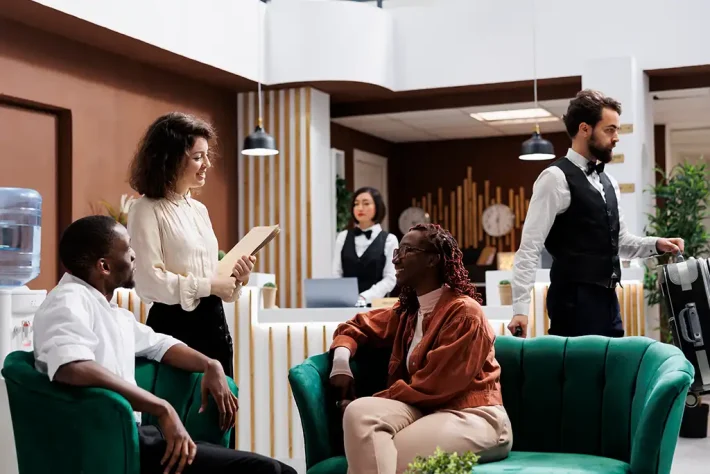The Ultimate Guide for the Brick-and-Mortar Startup

If you’re setting up a brick-and-mortar establishment, there are several things to consider to make it a success.
The term “brick and mortar” (also sometimes used as “bricks and mortar”) was created in contrast to online shopping or e-commerce. Before the internet grew large enough for online retail to become convenient and profitable, storefronts were just that — retail stores, outlets, storefronts, or just shops.
Although there was a dip in in-person shopping in the United States for several years, many consumers have returned to brick-and-mortar establishments — in part because there is some convenience, but more because they want a specific experience while shopping.
As a business owner looking to start a brick-and-mortar store, it is important to understand how in-person shopping and online shopping work together, and how you can keep your customers satisfied with their overall retail experience.

The Fall and Return of Brick-and-Mortar Establishments
During the 2009 recession, many brick-and-mortar stores suffered financially. As the economy has recovered, many economists have discussed the differences between online and brick-and-mortar stores.
For many years, logic dictated that the lower operating costs, portable shopping, and ease of setup made e-commerce solutions the obvious choice for anyone starting a business. But with customers seeking out in-person shopping experiences as the economy started to recover, brick-and-mortar stores found themselves with competitive advantages over online retail.
Brick-and-mortar stores have these benefits:
- Talking directly with a person when questions or concerns arise
- Seeing, holding, and trying items before purchase
- Having the item immediately
- Feeling the business is more legitimate
- No shipping charges
- An overall sensory experience
A report from PricewaterhouseCoopers’ Global Consumer Insights Survey states that, between 2015 and 2018, the number of shoppers in brick-and-mortar stores on a weekly basis increased: from 40 percent to 44 percent.
International Council of Shopping Centers found that 73 percent of surveyed customers reported they preferred to shop in person so they could try items before buying them.
While e-commerce may have the appeal of being new, 87 percent of all retail sales still occur in brick-and-mortar storefronts.
An Integrated Approach: An Online Presence & a Brick-and-Mortar Location
Since 2009, there has been a lot of crossover between online and brick-and-mortar retail. The two are beginning to work synchronously. As a business owner, understanding how patrons view these new “click and mortars” or “bricks and clicks” is crucial.
While brick-and-mortar storefronts are still an important and thriving business model, one of the most important draws into stores, foot traffic, is declining annually. Modern shoppers go into brick-and-mortar stores with specific intentions rather than for just casual shopping.
About three-quarters of U.S. adults report regularly shopping online, half report casually looking at items in stores then purchasing online, and two-thirds report browsing online stores and then purchasing items in a store.
With more potential customers doing both, you as a business owner must find ways to bring shoppers into your store and have them return. In part, this means understanding the costs to you as a business owner of starting a brick-and-mortar store and the now requisite integration of an online presence.
The Basics of Creating a Modern Brick-and-Mortar Startup
When starting a new business, there are a few basics you need to consider regardless of whether you are a brick-and-mortar or e-commerce retailer.
- Business plan: A business plan is a formal document that outlines business costs, the purpose of your business, and how you plan to become profitable over several years. Mission statements, reports on your competition, and plans to bring in your target market are all part of the business plan.
While you can start an e-commerce store without a business plan — you can start a website, get a payment service, and start selling any merchandise you have with very little upfront investment — a business plan helps you understand the larger structure of your company and how it can grow and change. This means your business will stick around longer.
Brick-and-mortar retailers greatly benefit from clear business plans because you can show them to banks for loans, investors for capital, and potential board members for large donations.
- Location: Even your online location – whether you retail through an existing ecommerce platform like Etsy or Amazon, or through a website you created – is important. Different demographics are drawn to business names and approaches to online marketing.
Location is even more important for brick-and-mortar stores, as they must now consider online presence as well as potential foot traffic.
- Financing: Brick-and-mortar stores are much more expensive to start than online shops. While paying for a domain name and payment processing service are the basic steps to starting an online shop, starting a true storefront requires a business loan or startup capital.
You must pay for the space by renting, leasing, or buying the property. You must pay for stock for your store, payment processing equipment, shelves and display furniture, utilities, and employee costs.
- Marketing: As a brick-and-mortar business owner, you must think about marketing — in print, online, on the radio, or on TV — and how those costs will affect your business’s stability. Thinking about this problem early can give a brick-and-mortar store more longevity.
There are some other considerations when starting a small business, such as these:
- Basic business operating license
- Federal employer identification number (EIN)
- Zoning and land use permits
- Health department permits
- Sales tax licenses
- Fire department permits
- Occupational or professional licenses
- Any state- and city-specific licenses or permits

Choosing the Location for Your Brick-and-Mortar Store
The location of your brick-and-mortar store will be one of the most important considerations.
Foot traffic is essential, so sidewalks, parking, and compliance with the Americans with Disabilities Act (ADA) are very important factors. While it’s ideal to be located in an area where there are a lot of shops, make sure the location works for your target demographic. It doesn’t matter if a lot of people walk through your store if they aren’t buying from it.
Consider the population size and makeup of the area. Does the profile fit your target audience?
Understand where your competitors are located, and decide how close you want to be to your competition. It can actually increase sales if you are in close proximity to your competition. You can even benefit from your competitors’ marketing.
Assess the safety of the area, traffic patterns, proximity to public transportation, and ease of parking. You want to ensure potential customers feel safe and the experience is easy for them.
As always, cost is a major factor. Rent in high-traffic, desirable areas will be higher, but a good location may have the biggest impact on your bottom line.
Associated Costs
The upfront operating costs of a brick-and-mortar establishment can look intimidating. There are various things to factor into financial estimates on your initial spending:

While all these costs add up, if you combine your storefront with a strong online presence — even if customers cannot make purchases through your website — you can create a lasting business.
Alternatives to Traditional Brick-and-Mortar Startups
If you choose to open a traditional storefront because you strongly believe your business needs a physical presence, you may be shocked by some of the above estimates. Starting a business with a real-world location, whether a warehouse or retail front, can appear imposing at first glance. There are some other methods for creating a physical presence in the world that still require financial investment upfront, but may cost less.
Some alternatives to a traditional brick and mortar storefront include:
- Kiosks, which can be placed in areas with high foot traffic, increasing the chance that a passerby will make an impulse buy.
- Farmer’s market stalls, which can even benefit non-food businesses like jewelry or pottery artisans.
- Food trucks, which are portable.
- Mobile rental units, which can house a small amount of merchandise and park in a different location for greater visibility.
- Popup shops, allowing groups of small business owners to sell their wares together for much lower rent.
These options are lower cost than classic storefronts, but they must still be professional in appearance and support a great customer experience. That requires investing in the creation of an appealing space, which can bring customers in and make them want to come back.
One recommendation for brick-and-mortar business owners involves creating an experience-rich environment for customers. The intention of any retail establishment, whether online or in person, is to convert browsing into buying.
Brick-and-mortar storefronts have a unique opportunity to create a calming or exciting environment for shoppers through architecture, interior design, lighting, and even sound and scent, to encourage casual shoppers to buy the items. Some larger retailers are adding cafes, bars, complimentary workshops, and fitness classes to their storefronts to build loyalty. Other options include hosting events or popup shops, working with other nearby retailers for discounts, and adding corresponding products or discounts to customers’ purchases.
These recommendations are all great, but if you are just starting out, there are some smaller, more consistent methods you can use to improve shoppers’ moods and experiences.

Creating an Inviting Space
When you begin thinking of your customers’ sensory experience in your store or creating an experience-rich environment, you may worry that you’re pulling focus from your merchandise. You may be concerned about the cost of adding a café or performance space to your storefront, hiring people to run that business, and managing the times those experiences are available.
There are small improvements you can make to your brick-and-mortar store that are much easier to manage. Music is one of the most overlooked yet most psychologically enhancing sensory additions you can bring to your store.
Much of the research conducted on psychological associations with music, especially in commercial establishments, concludes that:
- Humans have emotional reactions to music.
- Time/tempo, pitch, and texture can all elicit specific emotional responses, which shoppers will associate with your items and your brand.
- Personal preference in music can moderate different individuals’ emotional experiences, so carefully chosen music can appeal to your business’s target demographic.
Whether it is fast or slow, the tempo of a song can influence the speed at which shoppers move through your store. Higher-pitched music tends to sound happier while lower pitches are associated with negative emotions. Familiarity with the music could influence a specific shopper’s trust and enjoyment of the establishment.
Even brand-new brick-and-mortar stores can use music to create a vibrant ambiance that draws in repeat customers. However, the use of music is a cost that few retailers stop to think about.
Did you know that using a personal streaming service, like Pandora or Spotify, or even playing your personal CDs, is illegal in a brick-and-mortar store without specific licenses?
Music Licensing for Startups
When you purchase an album or pay a subscription price for ad-free music streaming on your personal devices, you have a specific license to play those songs privately. You can listen to them as much as you want, but you cannot play them for other people if there is any potential profit involved, even if the music is in the background.
When a large enough group of people are in one location and can hear a specific composition, regardless of whether the music is prerecorded, this is considered a public performance of the work. To legally play a song, you must obtain a license from the performing rights organization (PRO) that manages the copyright and licensing distribution for the artist or negotiate directly with the copyright holder — the artist or their estate.
PROs license catalogs of music — often hundreds of thousands of compositions — so that when you, as a business owner, purchase a license, you can play any group of songs in that catalog to create the specific atmosphere you want in your brick-and-mortar store. The largest PROs in the U.S. include:
- Broadcast Music, Inc. (BMI)
- The American Society of Composers, Authors, and Publishers (ASCAP)
- SESAC
- Global Music Rights (GMR)
While it is very easy to obtain a music license online with these organizations, each PRO manages a different catalog. Many brick-and-mortar business owners find that they purchase licenses with more than one PRO, so they can have access to a combination of songs that creates the best possible atmosphere in their establishment.
One easy way for a new brick-and-mortar establishment to reduce costs for music is to work with a music licensor. This gives you access to more songs in more catalogs.
How to Legally Play Music at an In-Store Event
If you host an in-store event at your brick-and-mortar location, music is essential. You want people to relax and have fun at this event, and without music, that’s next to impossible.
You’ll need to ensure the music played at the event is properly licensed. Since your business is benefiting from this public performance of music, the responsibility falls on you.
If you subscribe to a professional streaming service, like CloudMusic, you’re covered in terms of background music licensing. You must have the correct account, a business streaming account, as your personal streaming account (like Spotify or Pandora) will not cover commercial use.
Sources
- Brick and Mortar. (2018). Investopedia.
- Retail vs. E-Commerce Trends: A Match Made in Heaven. (2018). Retail TouchPoints.
- Quarterly Retail E-Commerce Sales 4th Quarter 2021. (February 2022). U.S. Census Bureau.
- Planning Process for Brick & Mortar Companies. (August 6, 2018). Small Business, Houston Chronicle.
- Information and Technical Assistance on the Americans with Disabilities Act. United States Department of Justice and Civil Rights Division, ADA.org.
- Starting a Business: License and Permit Checklist. Small Business Law, FindLaw.
- Start Up Costs for Running a Retail Business. (June 30, 2017). Small Business, Houston Chronicle.
- How Much Does It Cost to Start a Retail Store? (October 9, 2017). ShopKeep.
- Retailing on a Budget: 7 Brick-and-Mortar Alternatives. (July 14, 2015). Business News Daily.
- 5 Strategies to Future Proof Your Brick-and-Mortar Store. (January 10, 2017). Shopify Blogs.
- Music: The Heartbeat of a Bricks and Mortar Store. (July 31, 2014). Sydney Morning Herald.
- Music and the Shopper. (December 3, 2014). Psychology Today.
Sign up and start listening today
Get our most exclusive features with a no-obligation 14-day trial.



